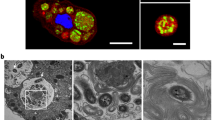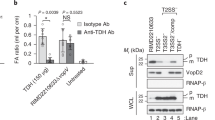Abstract
Cyclo(Phe-Pro) (cFP), produced by the Vibrio species, plays the dual roles of being a signaling molecule and a virulence factor. Acting modes of this compound have recently been characterized at the molecular level. Nevertheless, the method by which this compound passes across biological membranes remains obscure. Using radiolabeled cFP, we examined the kinetics of transport for this compound across membranes using V. vulnificus, Escherichia coli, and sheep red blood cells. We observed that cFP was taken up by these cells in a concentration-dependent manner and was not affected by the addition of the proton ionophore carbonyl cyanide m-chlorophenyl hydrazone (CCCP), suggesting that cFP is taken up by passive transport. The kinetics of uptake of cFP by the above three types of cells revealed no significant differences, indicating that no specific protein is involved in this process. When the intracellular accumulation of cFP in the tested cells was measured, the concentrations did not exhibit significant differences between the 1-min and 10-min time points after cFP was added to the culture. In contrast, the intracellular concentration of fumarate, which is well known to be taken up by cells via active transport, was significantly higher at the 10-min than at the 1-min time point after addition. Taken together, this study shows that cFP is a diffusible molecule that does not require energy for transportation across biological membranes, and that cFP does not need membrane machinery in order to cross membranes and consequently act as a virulence factor or signal.
Key Points
• Kinetics of cFP uptake into cells of V. vulnificus, E. coli, or RBS was studied.
• The uptake was not saturated and required no energy, indicating passive transport.
• The lack of cell specificity in cFP uptake means no specific protein is needed.
• Therefore, the cFP moves across the biological membrane by simple diffusion.





Similar content being viewed by others
References
Belin P, Moutiez M, Lautru S, Seguin J, Pernodet JL, Gondry M (2012) The nonribosomal synthesis of diketopiperazines in tRNA-dependent cyclodipeptide synthase pathways. Nat prod rep 29(9):961–979. https://doi.org/10.1039/c2np20010d
Bellezza I, Peirce MJ, Minelli A (2014) Cyclic dipeptides: from bugs to brain. Trends Mol Med 20(10):551–558
Bina XR, Bina JE (2010) The cyclic dipeptide cyclo (Phe-Pro) inhibits cholera toxin and toxin-coregulated pilus production in O1 El Tor Vibrio cholerae. J Bacteriol 192(14):3829–3832. https://doi.org/10.1128/JB.00191-10
Bina XR, Taylor DL, Vikram A, Ante VM, Bina JE (2013) Vibrio cholerae ToxR downregulates virulence factor production in response to cyclo (Phe-Pro). MBio 4(5):e00366–e00313. https://doi.org/10.1128/mBio.00366-13
Childers BM, Klose KE (2007) Regulation of virulence in Vibrio cholerae: the ToxR regulon. Future Microbiol 2(3):335–344. https://doi.org/10.2217/17460913.2.3.335
Cura AJ, Carruthers A (2011) Role of monosaccharide transport proteins in carbohydrate assimilation, distribution, metabolism, and homeostasis. Compr Physiol 2(2):863–914. https://doi.org/10.1002/cphy.c110024
Davies SJ, Golby P, Omrani D, Broad SA, Harrington VL, Guest JR, Kelly DJ, Andrews SC (1999) Inactivation and regulation of the aerobic C4-dicarboxylate transport (dctA) gene of Escherichia coli. J Bacteriol 181(18):5624–5635
Ghoul M, Pommepuy M, Moillo-Batt A, Cormier M (1989) Effect of carbonyl cyanide m-chlorophenylhydrazone on Escherichia coli halotolerance. Appl Environ Microbiol 55(4):1040–1043
Graz CJ, Grant GD, Brauns SC, Hunt A, Jamie H, Milne PJ (2000) Cyclic dipeptides in the induction of maturation for cancer therapy. J Pharm Pharmacol 52(1):75–82. https://doi.org/10.1211/0022357001773535
Greenberg EP, Hastings JW, Ulitzur S (1979) Induction of luciferase synthesis in Beneckea harveyi by other marine bacteria. Arch Microbiol 120:87–91. https://doi.org/10.1007/BF00409093
Huang R, Zhou X, Xu T, Yang X, Liu Y (2010) Diketopiperazines from marine organisms. Chem Biodivers 7(12):2809–2829. https://doi.org/10.1002/cbdv.200900211
Kaplan HB, Greenberg EP (1985) Diffusion of autoinducer is involved in regulation of the Vibrio fischeri luminescence system. J Bacteriol 163(3):1210–1214
Kim IH, Kim SY, Park NY, Wen Y, Lee KW, Yoon SY, Jie H, Lee KH, Kim KS (2018) Cyclo-(l-Phe-l-Pro), a quorum-sensing signal of Vibrio vulnificus, induces expression of hydroperoxidase through a ToxR-LeuO-HU-RpoS signaling pathway to confer resistance against oxidative stress. Infect Immun 86(9):e00932–e00917. https://doi.org/10.1128/IAI.00932-17
Kim IH, Son JS, Wen Y, Jeong SM, Min GY, Park NY, Lee KW, Cho YJ, Chun J, Kim KS (2013) Transcriptomic analysis of genes modulated by exogenous cyclo (L-phenylalanine-L-proline) in Vibrio vulnificus. J Microbiol Biotechnol 23(12):1791–1801. https://doi.org/10.4014/jmb.1308.08068
Kim K, Kim NJ, Kim SY, Kim IH, Kim KS, Lee GR (2015) Cyclo (Phe-Pro) produced by the human pathogen Vibrio vulnificus inhibits host innate immune responses through the NF-κB pathway. Infect Immun 83(3):1150–1161. https://doi.org/10.1128/IAI.02878-14
Lee K, Jeong JE, Kim IH, Kim KS, Ju BG (2015) Cyclo (phenylalanine-proline) induces DNA damage in mammalian cells via reactive oxygen species. J Cell Mol Med 19(12):2851–2864. https://doi.org/10.1111/jcmm.12678
Lee W, Lee SH, Kim M, Moon JS, Kim GW, Jung HG, Kim IH, Oh JE, Jung HE, Lee HK, Ku KB, Ahn DG, Kim SJ, Kim KS, Oh JW (2018) Vibrio vulnificus quorum-sensing molecule cyclo(Phe-Pro) inhibits RIG-I-mediated antiviral innate immunity. Nat Commun 9(1):1606. https://doi.org/10.1038/s41467-018-04075-1
Park DK, Lee KE, Baek CH, Kim IH, Kwon JH, Lee WK, Lee KH, Kim BS, Choi SH, Kim KS (2006) Cyclo (Phe-Pro) modulates the expression of ompU in Vibrio spp. J Bacteriol 188(6):2214–2221. https://doi.org/10.1128/JB.188.6.2214-2221.2006
Park JH, Cho YJ, Chun J, Seok YJ, Lee JK, Kim KS, Lee KH, Park SJ, Choi SH (2011) Complete genome sequence of Vibrio vulnificus MO6-24/O. J Bacteriol 193(8):2062–2063
Park NY, Kim IH, Wen Y, Lee KW, Lee S, Kim JA, Jung KH, Lee KH, Kim KS (2019) Multi-factor regulation of the master modulator LeuO for the cyclic-(Phe-Pro) signaling pathway in Vibrio vulnificus. Sci Rep 9:20135
Pearson JP, Van Delden C, Iglewski BH (1999) Active efflux and diffusion are involved in transport of Pseudomonas aeruginosa cell-to-cell signals. J Bacteriol 181(4):1203–1210
Prasad C (1995) Bioactive cyclic dipeptides. Peptides 16(1):151–164. https://doi.org/10.1016/0196-9781(94)00017-z
Reddy GP, Hayat U, Abeygunawardana C, Fox C, Wright AC, Maneval DR Jr, Bush CA, Morris JG Jr (1992) Purification and determination of the structure of capsular polysaccharide of Vibrio vulnificus M06-24. J Bacteriol 174(8):2620–2630. https://doi.org/10.1128/jb.174.8.2620-2630.1992
Rhie MN, Yoon HE, Oh HY, Zedler S, Unden G, Kim OB (2014) A Na+-coupled C4-dicarboxylate transporter (Asuc_0304) and aerobic growth of Actinobacillus succinogenes on C4-dicarboxylates. Microbiology 160(7):1533–1544. https://doi.org/10.1099/mic.0.076786-0
Taubert D, Grimberg G, Stenzel W, Schömig E (2007) Identification of the endogenous key substrates of the human organic cation transporter OCT2 and their implication in function of dopaminergic neurons. PLoS ONE 2:e385
Woronowicz K, Olubanjo OB, Sha D, Kay JM, Niederman RA (2015) Effects of the protonophore carbonyl cyanide m-chlorophenylhydrazone on intracytoplasmic membrane assembly in Rhodobacter sphaeroides. Biochim Biophys Acta 1847(10):1119–1128. https://doi.org/10.1016/j.bbabio.2015.06.002
Funding
This work was supported by grants from the National Research Foundation (NRF) of Korea funded by the Ministry of Science and ICT (2017R1A2B2006966 and 2019R1A2C2084282), Republic of Korea.
Author information
Authors and Affiliations
Contributions
KK and OK designed the research, and NP conducted the experiments. NP and KK wrote the manuscript. YC conducted the experiments for revision. All authors have read and approved the manuscript.
Corresponding authors
Ethics declarations
Conflict of interest
The authors declare that they have no conflicts of interest.
Ethical approval
This article does not contain any studies with human participants or animals performed by any of the authors.
Additional information
Publisher’s note
Springer Nature remains neutral with regard to jurisdictional claims in published maps and institutional affiliations.
Electronic supplementary material
ESM 1
(PDF 104 kb)
Rights and permissions
About this article
Cite this article
Park, NY., Cho, Y.B., Kim, O.B. et al. Cyclo(Phe-Pro) produced by Vibrio species passes through biological membranes by simple diffusion. Appl Microbiol Biotechnol 104, 6791–6798 (2020). https://doi.org/10.1007/s00253-020-10646-4
Received:
Revised:
Accepted:
Published:
Issue Date:
DOI: https://doi.org/10.1007/s00253-020-10646-4




